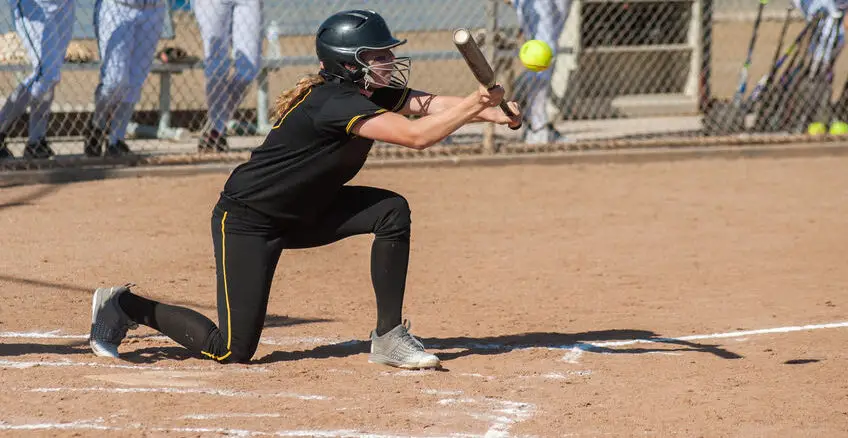
The softball sacrifice bunt is an important tool used to advance baserunners. It is usually done with less than 2 out and a runner on first base but can also be done with a runner on second. The batter is believed to be sacrificed and is sort of expected to be out at first base. If she gets on base it’s a bonus. It is also used when there is a batter who is having trouble hitting the ball or if it is late in a close game and you need to get a runner into scoring position. Unless the bunt is right to the pitcher or another infielder, a double play is difficult in a sacrifice bunt.
Softball Sacrifice Bunt
The point of the bunt is to sacrifice the batter to advance a runner. There is no surprise therefore no need to quickly get into position after the ball is pitched. This is something that can be difficult for players to understand so they have a hard time setting up before the pitcher pitches the ball. Coaches need to emphasize that it is about the runner ahead of the batter and so she needs to get the ball into play.
Setting Up
The batter moves to the front of the batters box so that when she makes contact, the ball will land in fair territory and not on the plate where it can roll or bounce into foul territory. From the batting position, she pivots on the balls of her feet and rotates her shoulders and hips toward the plate so that her hips and shoulders are square to the pitcher. At the same time, she slides her top hand up the handle so that one hand is at the bottom of the handle and the other is up the barrel just past where the barrel widens (about the middle of the bat).
The eyes are looking straight ahead at the pitcher and must stay on the ball the entire way right from the release point to contact or when it passes the bat. The stance is relaxed and balanced. If the pitch is at the bottom of the strike zone, the batter will lower the bat by lowering the body using the knees. If the ball is above the bat then the batter will simply let it go, and pull the bat back indicating to the umpire that she has no intention of bunting.
Notice that the body is square to the pitcher and the bat is at the top of the strike zone. The elbows are also pointing down and not out to the side. This provides more control and a better ability to absorb the ball as if catching it with the bat. This way, the ball is less likely to pop off the bat to an infielder.
The hand that is up on the barrel is set so that the fingers do not wrap around the bat. This is to prevent the fingers from getting hit by the ball. Young bunters will have difficulty bunting if they get hit by the ball because they will be afraid of it. The index finger tucks behind the bat while the thumb is parallel and supporting the bat forming a V between the thumb and index finger..
In the image the top hand grip is below the width change of the bat, The batter may also more comfortable with it a bit higher, closer to the bat logo, to give them more control. with the elbows bent as mentioned, and the bat cushioning the contact, the player will not need to worry about holding the bat too tight.
For the bottom hand or one at the bottom of the handle, the palm is almost facing the pitcher, the batter should be able to point up to the sky with their index finger. This is a somewhat relaxed position. When getting into bunting position, as the batter is rotating and pivoting, as the top hand slides up the barrel, the bottom hand loosens the grip so that the bat can be rotated in their palm to get into the correct position.
The bottom hand controls the direction and the angle of the bat. The top hand basically holds the bat balanced and keeps the ball from bouncing off the bat and going foul on a fast pitch. Having the elbows bent and hanging down works to facilitate absorbing the pitch.
The angle of the bat in the sacrifice bunt ready position will depend on the coaching philosophy and sometimes the experience level of the player. A new player will have more success by showing a level bat for the bunt because there is more surface area to catch the ball with. Some more advanced teams may use an angle bat because they feel they can direct the ball more or they are going to use it as a decoy for a slap bunt. The difficulty with having the bat on the angle is that it gives a smaller area to meet the ball with which can be difficult for new players.
The body position is in front of the batters box and relaxed with the bat out in front of the body far enough to provide some cushion but not so far that the arms are straight and the ball just bounces off the bat. A comfortable position just slightly lower than the regular batting position is perfect because it allows room to move if the ball is pitched below the bat. This will make it easier to bunt a ball low in the strike zone but also to know if the ball is not a strike if it is pitched higher than the bat. By moving the bat up or down and not the body to bunt the ball, there is a bigger chance of the ball popping foul because of the spin on the ball. The goal is to catch the top half of the ball with the bottom half of the bat. This will drop the ball in front where it can be difficult to field and can cause confusion by the defense.
